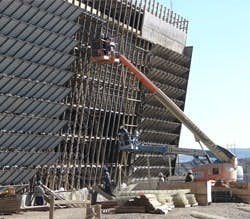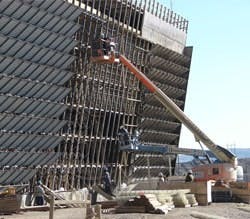Utility achieves contract transparency and cost control
Almost 500,000 customers receive their electricity from PNM (www.pnm.com), a utility headquartered in Albuquerque, New Mexico. PNM relies on skilled contract labor for plant maintenance and complex construction projects. For years, PNM handled its contractor spend, from timesheets to invoicing, manually. With an outside services budget reaching $100 million during its last back-to-back major overhaul and peaking at more than 1,000 on-site contractors, PNM needed more visibility and accountability and a more efficient process for managing the work and dollars associated with that budget.
Contract visibility
In July 2009, PNM sought a way to automate its contractor management process, improve administrative efficiency and reduce inaccuracies in invoicing. It chose Track software’s Labor module.
“There was entirely too much manual entry being done, from timesheet processing to invoicing,” says Shay Jacquez, Track administrator for PNM. “It was difficult to capture costs in one place and be able to provide accurate status updates. Keeping our billed hours reconciled with a paper-based process and isolated computer systems required an immense amount of administrative time, both on our part and our vendors’ parts. It was estimated during an outage that we spent a minimum of two hours each day entering costs, while some of our vendors spent an average of eight hours a day on timekeeping and invoicing activities. These costs were passed on to PNM. We also didn’t have any timekeeping standardization among the contractors we worked with or a way to hold them accountable for their employees by the rules in their contracts.”
PNM chose to implement the module for contract cost management because it was compatible with PNM’s other existing enterprise systems, including Passport and Primavera. “Track’s software talked to our system while other vendors we considered couldn’t interface with the programs we had in place,” explains Jacquez. “Track’s design matched our workflow from the creation of the initial contract through payment processing. It fit our business process better because Track required the same key data as our process did from start to finish.”
PNM also chose the software because it could assist in planning. After collecting historical data, plant managers are able to generate reports showing manpower loadings during outages or the seasonal use of equipment, allowing PNM to project or budget future services and equipment, as well as idle time. Managers can also compare contractor productivity by examining manpower and equipment loadings for similar jobs or time periods.
Pilot savings
A pilot project ran parallel with PNM’s previous contract management process over a period of three non-outage weeks, allowing the company to evaluate and prove potential cost savings. The system interfaced with PNM’s badge access control system (C-Cure) and was used by two of PNM’s major contractors at its San Juan Generating Station, the company’s largest generating plant.
PNM gained new visibility into its contractor spend and was assured of the accuracy of its timesheets and contractor invoices.
During the pilot, PNM used the software’s functions and features to determine that there was an average potential cost savings of about 10%. It also found contractor timesheet errors and was able to document questionable entries over the course of the pilot.
PNM estimated at the conclusion of the pilot that the software could potentially save the company as much as $8 million annually, based on 2010’s outside service budget. These findings allowed the utility to make a business case to justify the purchase and integration of the system on a broader scale to provide better reporting for cost control and project management.
“The system gave us control but also helped the contractors manage their employees and hold them more accountable,” says Jacquez.
More than savings
PNM discovered, as a result of the pilot, that its contractor agreements were missing necessary business rules, such as the incorporation of grace periods into pay formulas and specifying how early contract employees could leave without having their pay docked. Identifying opportunities for adding rules into contracts meant that both contractors and plant owners mutually agreed upon terms and that invoices were a more accurate reflection of work performed.
Security also was impacted. PNM began receiving near-real-time personnel security and safety reports, made possible by the software’s communication with its badge access control system. This data gave insight into contractor time in and out, but also provided data on plant employees’ presence on plant site, which had important safety and compliance implications.
Full implementation
The company decided to implement the Labor module in early 2010. “With the results demonstrated during the pilot phase, it was easy to convince management to implement Track plant-wide,” explains Jacquez. The first implementation, which occurred during two major outages, quickly crept from one contractor to eight and at one point included more than 1,000 contract employees’ time being processed. “A savings of 8% was realized on outage contract services during the first year of implementation," explains Jacquez. PNM relied on the software vendor’s personnel for questions with formulas, reports and problem solving, and it had full-time access to the software’s administrative and timekeeper support. The system was live with PNM by the end of the first quarter of 2010.
Increased visibility
With the system in place, PNM had new visibility into its contractor spend and was assured of the accuracy of its timesheets and contractor invoices. Many elements contributed to PNM’s return on investment.
- Capturing actual on-site hours and billing them appropriately: PNM required all workers to badge in and out, for compliance with federal plant safety and security mandates. The company is able to capture all gate activity in one system. The primary advantage is calculating hours based on activity, something that wasn’t being done before. The software also applies contract terms and conditions to activities and then determines how many hours should be allocated to each job.
- Decreasing errors: Timesheets reflected actual time worked. Reconciling timesheets with contracts meant that contractors invoice PNM accurately and that PNM had more control over its contractor payments.
- Identifying practices that were not included in the contract agreements: Tying contract terms to work activities means that the software module helped contractors hold their employees accountable to contract terms and conditions — for example, identifying overtime work improperly charged.
- Reducing manual timesheets: Timesheets are signed electronically, instead of manually. The system gives contractors the ability to download data directly to the payroll systems.
Ultimately, the system provided a streamlined process for the documentation and coordination of contract employee headcount each day. Hours and costs were allocated to specific project and work orders on a daily basis, providing a clear snapshot of actual work performed, and costs.
Additional implementation
The cost savings Track’s Labor module provided also led PNM to purchase Track’s Equipment and Materials module and schedule implementation for early 2012. The Equipment and Materials module manages contractor equipment and materials spend and is integrated with the other module. Terms are incorporated into contracts, and then automated, so anytime a contractor uses a truck or other specialized industrial equipment, or purchases materials or supplies, that information is reconciled to the contract and allocated to open authorized purchase order/work order/work breakdown structure elements.
“Incorporating equipment and material costs with our labor invoices should further streamline our work management processes, and simplify things administratively for our contractors,” adds Jacquez. “The Equipment and Materials module will also make invoices more accurate — for example, identifying equipment charged that wasn’t in the contract, or certain charges that should be included in the labor rate.”
With visibility into contractor time and activities, and new insight into equipment and materials management, PNM has the tools needed to secure accurate contractor invoices and control its total contractor spend, thus positively impacting budget and timetables of crucial plant construction and maintenance projects.

